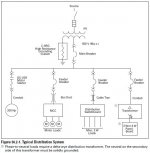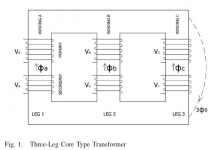MechEdetour
Member
- Location
- NY, USA
- Occupation
- Design Engineer
This might be a silly question, and I think I know what I am talking about but...
In a 480V high resistance grounded system, L-N loads are not allowed per NEC 250.36. If there are neutral loads to be serviced, a separately derived system can be installed (lets say a 480/277 transformer for lighting loads). The 480/277 system will be solidly grounded, and therefore OCPDs will trip in the event of a L-G fault. Upstream of the 480/277 system will still be high resistance grounded and therefore will only alarm on the first L-G fault.
An image taken from an Eaton application guide to convey a system like I am trying to describe:

I think it's my understanding of transformers that is lacking... With the 480/277 transformer being a solidly grounded separately derived system, it allows high levels of fault current to flow to trip OCPDs. But for both HRG and solidly grounded systems the requirements for equipment grounding conductors (EGCs) are more or less the same, the EGCs on the secondary side of the 480/277 transformer would still have continuity with the primary side, and therefore the HRG system as well.
So with all that being said, what is the "source" for fault current to return to if I have a fault on the 480/277 side? Or maybe in other words, how can I have high levels of fault current on the 480/277 side if further upstream (closer to the "source") I still have a neutral grounding resistor that limits my fault current to 5A?
I feel like it's alphabet soup with what I am trying to convey, but it's the best I can do for now.
In a 480V high resistance grounded system, L-N loads are not allowed per NEC 250.36. If there are neutral loads to be serviced, a separately derived system can be installed (lets say a 480/277 transformer for lighting loads). The 480/277 system will be solidly grounded, and therefore OCPDs will trip in the event of a L-G fault. Upstream of the 480/277 system will still be high resistance grounded and therefore will only alarm on the first L-G fault.
An image taken from an Eaton application guide to convey a system like I am trying to describe:
I think it's my understanding of transformers that is lacking... With the 480/277 transformer being a solidly grounded separately derived system, it allows high levels of fault current to flow to trip OCPDs. But for both HRG and solidly grounded systems the requirements for equipment grounding conductors (EGCs) are more or less the same, the EGCs on the secondary side of the 480/277 transformer would still have continuity with the primary side, and therefore the HRG system as well.
So with all that being said, what is the "source" for fault current to return to if I have a fault on the 480/277 side? Or maybe in other words, how can I have high levels of fault current on the 480/277 side if further upstream (closer to the "source") I still have a neutral grounding resistor that limits my fault current to 5A?
I feel like it's alphabet soup with what I am trying to convey, but it's the best I can do for now.


